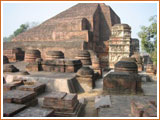Udayagiri Tour

At a distance of 5kms from Ratnagiri is Udaygiri. Udaygiri is Udaygirian important Buddhist pilgrimage in the state of Orissa, special due to its caves, which house some of the most antique and architecturally important sculptures of Buddhist origins. Not very far from Bhubaneswar, the place was a flourishing learning Centre of Buddhism, and still represents its rich history through the ruins of the ancient monasteries, stupas and other Buddhist items found in the place. Besides, this place is also considered holy by the Jains.
Udaygiri, the largest Buddhist complex in Orissa, has assumed further importance after the recent excavation, which revealed the ancient name of the monastery as Mahadevapura Mahavihar and brought to the light a sprawling complex of brick monastery with a number of Buddhist sculptures.
Located in the basin of u-shaped hill this Buddhist center is still not completely excavated. Along with Ratnagiri and Lalitgiri, these three hills are considered as the golden triangle of the Orissa tourism. The newly laid out hilly road, which has a serpentine passage along the foot hills, on the other side of Udaygiri is an added attraction and ensures all weather approach to the site.
The story associated.The Pag-Sam-Zan-Zang, a Tibetan text compiled in 1747 A.D. and Udaygiri Saddharmapundarika, another Buddhist scripture, both have important references to the Vajrayana Buddhism. According to the text, Buddha assured one of his chief disciples Sariputta, that he would reborn as Padmasambhava (who popularized vajrayana Buddhism in Tibet), after countless generations. And he would attain enlightenment at Budhhakshetra Uddiyana (Udaygiri), the place from where the Vajrayana sect is believed to have originated.

Vajrayana or Tantric Buddhism is a form of Buddhism that evolved as a challenge to the authority of the Buddha, and rejected the original form of the religion. The various kinds of worldly pleasures prohibited by the Buddha were introduced in the Vajrayana sect in the form of the five makaras or mediums, notably wine, women, fish, meat and parched grain. The Vajrayanists perceived the Buddha only as a mortal figure whose religious philosophy did not take into account the totality of a man's desires, and was therefore inadequate at certain levels. The followers of the Vajrayana sect, that had already come into being by the beginning of the 7th century A.D., formulated the concept of the five Dhyani Buddha’s, (the meditative Buddha’s) accompanied by their five consorts who were supposed to represent the five elements of nature.
These Buddha, namely Vairocana, Akshobhya, Ratnasambhava, Amitabha and Amoghasiddhi, were immortal, and along with their respective female partners, had created a number of Bodhisattvas (successive phases leading to the Buddha state). Each Bodhisattva was destined to realise eight mortals Buddha’s who were required to preach the Vajrayana doctrine and help people attain nirvana, or emancipation by embracing a woman. The union of a man and a woman was designated as yoga considered a powerful means to attain salvation. The followers of the Vajrayana sect, after attaining salvation were allowed to enjoy Prajnaparamita, or the perfect truth. According to the Vajrayana texts, Prajnaparamita lives in every woman on earth.
.jpg)
Hiuen Tsang Memorial Hall : The famous Chinese traveler who came to India in the 5th century AD and stayed in Nalanda for 12 years as a student and a teacher and studied the social and political conditions. The memorial hall was built in his memory.
Sadhanamala, a Tantric text mentions four pithas or sacred spots – Kamakhya, Srihatta, Purnagiri Lumbini and Uddiyana – which were the original seats of Vajrayana. While Kamakhya and Sirihatta are in modern Assam, speculations abound about Purnagiri corresponding to the modern Pune region in Maharashtra. Uddiyana had been identified with various places earlier. Indrabhuti was its ruler, and Padmasambhava was his second son. Padmasambhava went to Tibet to help Santaraksita of Zahor (now located in modern Bangladesh) build a great stupa (a Buddhist reliquary mound) at Samye. The text Sadhanamala mentions that Padmasambhava had destroyed some of his father's favourite texts, for which he was punished and sent to Tibet. It is further mentioned that he married one of Santaraksita's sister. According to the Pag-Sam-Zan-Zang, Tantric Buddhism had originated at Uddiyana.
How to reach NalandaBy Air : Bhubaneshwar is the nearest airport.
By Train : The nearest railway station is Ratnagiri.
By Road : Well connected by road. Taxis are recommendable than the buses.









